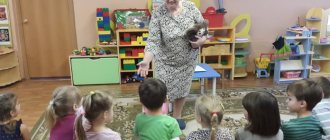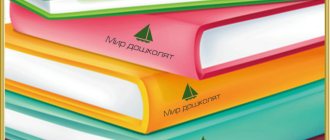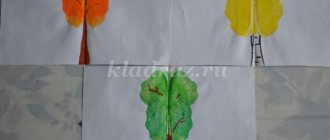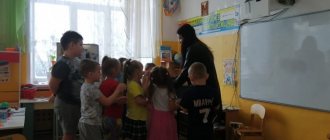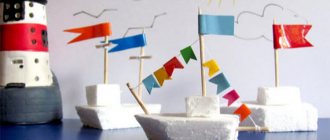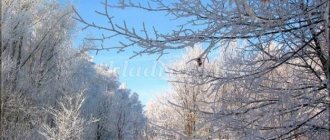MAGAZINE Preschooler.RF
Lesson summary “Traveling along an ecological trail in winter” (PO Poznanie)Objectives: Expand children’s understanding that in cold weather water turns into ice, snow melts in a warm room, form children’s understanding of the state of grass and trees in winter, their adaptability to changing conditions in winter, examine a spruce cone and clarify its features, form knowledge about natural phenomena, make analyzes and conclusions on the objects being studied, develop observation and mental activity, evoke joy from discoveries obtained during experiments and observations, show care and respect for trees and shrubs in winter.
Integration of educational areas: speech development, social and communicative development, physical development, artistic and aesthetic development.
Materials and equipment: ICT, bucket, carrot, containers with water, 12 sheets of paper according to the number of children, rags, cones according to the number of children, spatulas, two jars of water, tray.
Methodological techniques: surprise moment, game, questions, artistic expression, examination of objects, simple experiments, teacher’s story.
Vocabulary work: snowman, lumps, scales, frozen (water).
GCD move.
- Guys, guess the riddle. She opened her snowy arms and dressed all the trees in dresses. The weather is cold.
What time of year is this? (Winter)
- Today, I want to invite you to visit winter.
- What kind of winter is it? (snowy, cold, icy, frosty, crackling)
- Now I suggest you dress warmly and go visit the winter (a signal sounds and an electronic message appears on the screen, the children look at the screen).
Message text
- Hello guys! It's me - Snowman Postman. I'm coming to visit you, bringing a letter. Already at your door. Meet us!
- Guys, why do you think the postman is called Snowman? (because it's made of snow)
- Yes, it was made from snow. What kind of snow can you make a snowman from? (white, wet, sticky)
— What geometric shapes does a snowman consist of? (from a ball: large, medium and small)
— Our snowman has probably already arrived. I'll go have a look, and you wait.
(the teacher goes out the door and brings a bucket of water with a carrot, envelope)
- Oh, look what I found behind the door. (shows)
-Here is a bucket, water, carrots, but where is the snowman? - What could have happened to him? (didn’t get there, melted) - high level - What has our Snowman turned into? (into water) - low level
— You and I already know that a snowman is made from snow.
- What kind of snow can you make a snowman from - wet or dry?
- Let's check. Take and crumple a dry piece of paper (children come to the table and take a sheet of paper and try it)
- You see, the dry leaf didn’t turn into a round lump.
- I suggest putting it in water and rolling a ball out of a wet leaf (children put the ball in water, roll the ball)
- You see, the wet paper turned into a lump. Let's collect all the wet lumps in a bucket. (children add up)
— What happens to water when it’s very cold? (she freezes, turns into ice)
“I’ll ask you to take our lumps outside so that they can turn into a snowman again.” (then the teacher invites the children to get dressed and go outside)
Children go outside and see an envelope on a branch. The teacher opens the envelope, and in it is a route map. Shows it to the children.
- Children, what do you see on this map? (spruce, snowdrift, bush and “?”.)
— What do you think the “?” sign means? (children express their guesses) I think this is the place where our snowman is. Let's go look for him. On the way, we will look at the objects that are on the map. 1. Object - spruce (there are cones under the spruce) Observation “What is in the spruce cones?”
- What is this? (bumps)
The teacher shows two cones of different sizes.
- Guys, look at these bumps. What size are they: the same or different? (Different: one big, one small)
- What color is the bump? (Brown)
- Look at the bump, touch it, is it smooth or rough? (A little rough).
— Its scales, houses for seeds.
— The scales fit tightly to each other, in the cold they are in a closed state.
- Well, now our road has led us to the next object.
2. Object - acacia bush. Observation “Why do trees sleep in winter?”
- What is this? (bush)
- What is the name of the bush? (acacia)
— How does a shrub differ from a tree? (it does not have a main trunk, many trunks extend from the root)
- What do you have in common? (in winter they have no leaves, they sleep, stop eating and growing) - The branches of the bush are very fragile in winter and cannot be broken.
“Let the bush sleep, we won’t wake it up and we’ll go on looking for our snowman.”
Game “Snowflake, Ice, Snowdrift” (children run in a circle, stop at a signal and complete the task “snowflake” - spin in place, arms out to the sides; “ice” - freeze; “snowdrift” - bend over)
3. Object - snowdrift. Experience “Protective properties of snow”
- Guys, look at the snowdrift in front of us.
— There is a jar on the snowdrift. Look what's in it? (ice).
- What is ice? (this is frozen water)
— There’s a sign stuck in the snowdrift. Its arrow points down. What does this mean? (you need to dig up the snow)
(the teacher digs up and finds a jar of water)
- What's in the jar? (water)
- Why isn’t she cold? (because she was deep)
- What conclusion can be drawn? (the deeper, the warmer)
- Let's dig up the snow with a shovel. What do we see? (grass) - It turns out that snow and ice retain heat, which means they keep plants warm in winter.
-This means the plant roots and soil are warm and will not freeze. Snow protects plant roots from freezing
- Oh, look, here is our snowman.
- Look at the snowman. How did the lumps become? (icy, hard)
— What advice can we give to our snowman? (so that he always lives outside and does not go into the heat)
- So you and I visited winter.
—What did winter tell us? (that the scales of a cone are houses for seeds, about a bush that sleeps in winter, does not eat, does not grow, that the more snow, the warmer the plants)
— Thanks to winter (children leave for the group).
| Next > |

